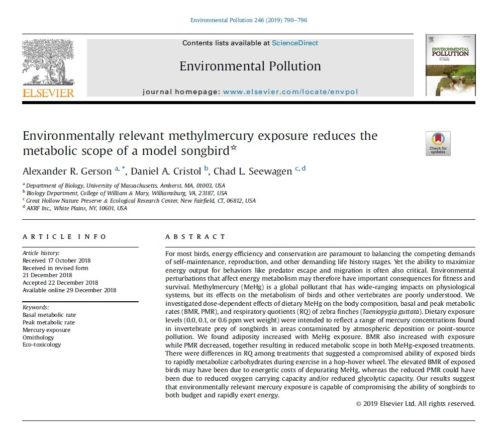
New Publication from Great Hollow’s Mercury Pollution Research Program
Great Hollow’s executive director, Chad Seewagen, is the coauthor of a new study that has been published in the current issue of the journal Environmental Pollution. The study examined the effects of mercury pollution on the metabolic rates of songbirds while at rest and during high-intensity activity. Mercury is a highly toxic and pervasive pollutant that has dramatically increased in the environment as a result of coal combustion, gold mining, cement production, hospital waste incineration, and various other human activities. Its full impacts on birds and other wildlife are only beginning to become understood. Like some other environmental contaminants, mercury has the potential to interfere with many of the physiological processes that regulate energy use in birds and other animals, but this has not been studied before. The ability of birds (and most other living things) to conserve and efficiently manage their energy is critical for reproduction, health and self-maintenance, and even their overall survival. For example, during winter when temperatures are cold and food is extremely limited, a bird’s ability to conserve energy can easily mean the difference between life and death. At the same time, the ability to rapidly exert large amounts of energy for behaviors like predator escape and long-distance flight is also of critical importance.
The study found that exposure to environmentally relevant levels of dietary mercury significantly increases the resting metabolic rate of birds while significantly reducing the maximum rate at which they are able to sustain a high-intensity behavior like flight (i.e., their “peak metabolic rate”). The increase in resting metabolic rate, which represents the energetic cost of maintaining basic bodily functions while at complete rest, is likely due to the energy required to detoxify and eliminate a poison like mercury from the body. This is energy that could otherwise be put towards beneficial processes like reproduction or put into storage, but is instead wasted on the elimination of the toxin. The decrease in peak metabolic rate is likely due to the effect that mercury has on the capacity of blood to transport oxygen from the lungs to the working muscles. What this all means is that birds living in mercury-contaminated environments (like much of the northeastern U.S.) may have a compromised ability to both budget and rapidly expend energy, which might ultimately impact their reproductive output and survival. This finding joins a growing body of evidence that even atmospheric mercury pollution, far away from factories or other “point-sources,” is having harmful effects on songbirds and other wildlife. Research on wildlife has been a significant impetus and source of support for improved mercury emissions regulations around the world, including the Minamata Convention — the first global treaty specifically intended to curb pollution from a heavy metal. The full article can be accessed here.
Gerson, A.R., D.A. Cristol, and C.L. Seewagen. 2019. Environmentally relevant methylmercury exposure reduces the metabolic scope of a model songbird. Environmental Pollution 246(2019):790-796.

 Previous Post
Previous Post Next Post
Next Post